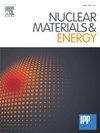Investigation of boron powder flow rates on real-time wall
IF 2.3
2区 物理与天体物理
Q1 NUCLEAR SCIENCE & TECHNOLOGY
引用次数: 0
Abstract
The limit of boron flow rates for real-time conditioning of the first walls has been systematically investigated in the Experimental Advanced Superconducting Tokamak (EAST) with a full metal wall. Initially, solid boron injection demonstrated effective control over carbon impurities and deuterium recycling on the basis of pre-discharge boronization. A minimum flow rate, identified between 1.0 mg/s and 2.0 mg/s, was necessary for actively improving wall conditions under specific plasma operating scenarios, with this effect progressively enhancing as boron flow rates increased. Additionally, a maximum flow rate, estimated between 3.5 mg/s and 8.0 mg/s, was identified for these plasma conditions. When boron flow rates exceeded this maximum, boron-induced fueling effects influenced the plasma line-averaged density, and at excessively high flow rates, plasma disruption was observed.
求助全文
约1分钟内获得全文
求助全文
来源期刊

Nuclear Materials and Energy
Materials Science-Materials Science (miscellaneous)
CiteScore
3.70
自引率
15.40%
发文量
175
审稿时长
20 weeks
期刊介绍:
The open-access journal Nuclear Materials and Energy is devoted to the growing field of research for material application in the production of nuclear energy. Nuclear Materials and Energy publishes original research articles of up to 6 pages in length.
 求助内容:
求助内容: 应助结果提醒方式:
应助结果提醒方式:


